Vaishali the place where monkeys offered honey to Buddha.
As usual the hotel morning call at 5am and breakfast at 6am. At 7am we departed Rajgir for a 5hr drive to Vaishali, where the Second Buddhist Council was held after 100 years of Buddha’s Parinirvana.
On the long road journey we passed through the longest Indian road bridge about 6km across river Ganges from Patna to Hajipur. We only arrived at the hotel at 12noon for lunch. At 1.30pm we proceeded for site visit to the excavated remains of Kolhua where Lord Buddha delivered his last sermon. Later, Emperor Asokha erected a huge Pillar to commemorate the spot of the last sermon.
We also visited the remains of Buddhist Stupa, Vaishali, Vishwa Shanti Stupa (World Peace Pagoda) and the Vietnamese Buddhist Stupa-Vihara.
Lunch / Dinner and overnight at Hotel Vaishali Residency.

A little shop by the lakeside edge on drive to Vaishali from Rajgir.

Passing through some of the villages open market along the road journey to Vaishali from Rajgir.

Passing through some of the villages open market along the road journey to Vaishali from Rajgir.

Passing through some of the villages open market along the road journey to Vaishali from Rajgir.

Our buddhist guide Mr Sharad briefing us in the bus and also some commentaries of the Buddhist pilgrimage.

Datuk Seri also gave us interesting Buddhist commentaries on the road journey to Vaishali from Rajgir.

In view of the long road journey to Vaishali from Rajgir and to kill time, everyone had to come to the microphone to introduce themselves. Standing here is Ching Bee Geok.

That was Ching Neng Bin telling his story.

Incredible India - people sitting on roof of Truck on the road journey to Vaishali from Rajgir.

Incredible India - kitchens are in front of houses out in the open space by the road side in Bihar.

Incredible India - food seller in front of houses out in the open space by the road side in Bihar.

Incredible India - chicken seller in front of houses out in the open space by the road side in Bihar.

Incredible India - shack houses out in the open space by the road side in Bihar.

The longest 5.75km Mahatma Gandhi Setu bridge across river Ganges from Patna to Hajipur.

The longest 5.75km Mahatma Gandhi Setu bridge across river Ganges from Patna to Hajipur.
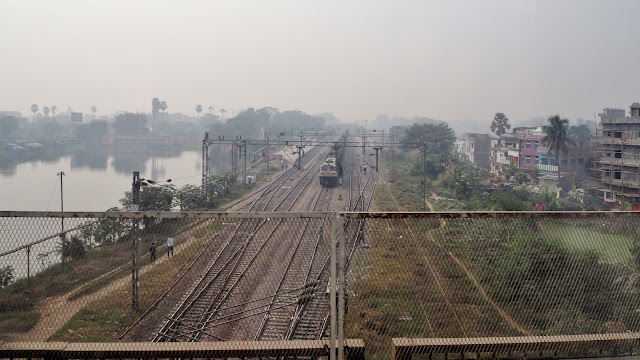
The road over the railway line in Bihar.

Lunch / Dinner and overnight at Hotel Vaishali Residency.
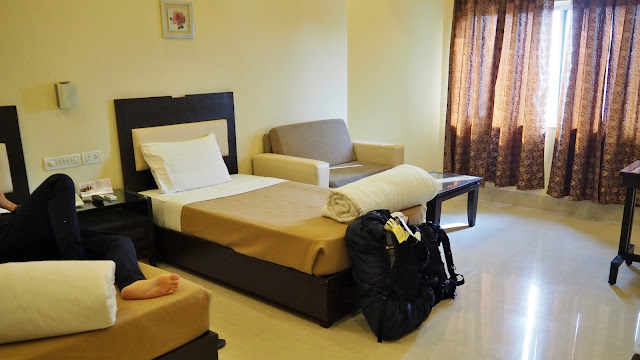
Lunch / Dinner and overnight at Hotel Vaishali Residency.

Incredible India - the poor farmers along the roads in Bihar.

Incredible India - the poor farmers along the roads in Bihar.

Incredible India - the poor farmers along the roads in Bihar.
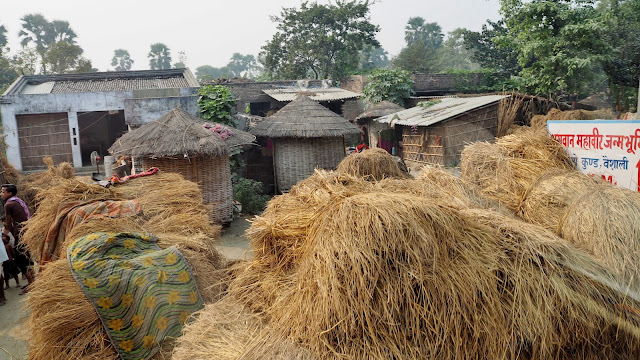
Incredible India - the poor farmers along the roads in Bihar.

Excavated remains of Kolhua, Vaishali, Bihar.

Excavated remains of Kolhua, Vaishali, Bihar.

Kolhua, a part and parcel of ancient city of Vaishali marks the spot where a local chief of monkeys had offered a bowl of honey to Lord Buddha. The event is regarded as one of the eight most significant events of his life according to the Buddhist literature. This was the place where Buddha spent many a rainy seasons, allowed nuns to the Sangha for the first time, announced his approaching Nirvana and converted Amrapali from a proud court dancer to a nun.

The recent ancient city of Vaishali excavations conducted by Archaeological Survey of India have revealed remains of Kutagarshala, Swastika shaped monastery, a tank, number of votive stupas and miniature shrines in addition to main stupa and the Asokan Pillar which were partly exposed earlier.

The ancient city of Vaishali Asokan Pillar locally known as Lat is 11 metres high monolithic polished sand stone column surmounted by a seated lion capital. It is probably one of the earliest pillars of Asoka which does not bear the usual edict. But a few letters in shell character of Gupta period are engraved on it.

Vaishali, Kothua, India, Lord Buddha delivered his last sermon.
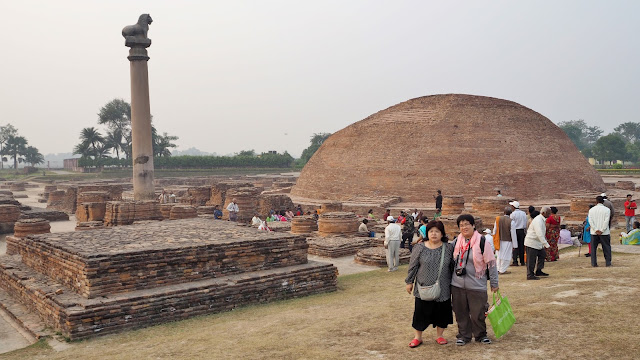
The ancient city of Vaishali brick stupa was erected to commemorate the event of offering honey to Buddha by the monkey chief. It was originally built during Mauryan period and subsequently enlarged in Kushana period by raising the height and providing brick paved circumlocutory path. Further brick encase in and addition of Ayakas at regular interval took place during Gupta and late Gupta periods.

The ancient city of Vaishali adjoining tank has been identified as ‘Markat-Hrid’ supposedly dug by the monkeys for Buddha. This brick lined seven tiered tank measuring approximately 65 x 35 metres in dimension has two bathing ghats on southern and western wings.

The ancient city of Vaishali beads of semi-precious stones, terracotta figurines, seals & sealings, bricks embedded with semi-precious stones, inscribed potsherd and a unique terracotta figure of crowned money are some noteworthy antiquities found during excavations of this site.

Bro. Wong Mun Heng meditating at the ancient city of Vaishali.

The ancient city of Vaishali.

Our chanting and meditation session led by Datuk Seri Dr. Victor Wee in the ancient city of Vaishali.

Our chanting and meditation session led by Datuk Seri Dr. Victor Wee in the ancient city of Vaishali.

Our chanting and meditation session led by Datuk Seri Dr. Victor Wee in the ancient city of Vaishali.

Remains of Buddhist Stupa, Vaishali. This is one among the eight relic stupas built over the corporeal remains of Buddha. The remains were distributed among eight claimants, one being the Lichchavis of Vaishali. The innermost Stupa of a smaller dimension, measuring 8.07m.

Further commentaries by Datuk Seri Dr. Victor Wee. A Stupa was erected by the Lichchhavis on the holy relics of Lord Buddha. The remains of the stupa can be seen at this place. Vaishali is further celebrated in the history of Buddhism as the site of second Buddhist council. At the modern Kolhua, Maurayan emperor Ashoka erected a lion pillar and a brick stupa.

Relic Stupa of the Licchavis - stands an open shelter with a dome-shaped roof. Inside it, are the remains of a stupa, which was originally a mud structure 25 feet in diameter with thin layers of cloddy clay. It appeared to have undergone enlargement and repairs four times, in which burnt bricks were used. The third enlargement increased its diameter to 40 feet and the fourth being in the form of a buttress supporting the third. The original mud stupa was a very old one, believed to be pre-Mauryan. From its primitive features and from the fact that a 2’6” trench had been driven into its core in olden times it is believed that this stupa is none other than the one erected by the Licchavis over their share of the relics of the Buddha. The trench was probably excavated by Asoka to reach the relics, some of which according to Hsüan Tsang, were left in their original position by Asoka.

In the centre of the original mud stupa, lying in the lowest layer of soil anciently disturbed by the trench, archaeologists in 1958 found a relic casket of soapstone (steatite) cracked from the pressure above. It contained one-fourth full of ashy earth, a piece of gold leaf, two glass beads, a small conch and a copper punch-marked coin. Based on the archaeological, literary and traditional evidence available, the archaeologists are of the opinion that this mud stupa is the one built by the Licchavis and the casket it contained most probably enshrined a portion of the ashes of the Buddha mixed with a lot of earth collected at his cremation. That it should be only one-fourth full reminds us of the statement made by Hsuan Tsang that: “Asoka, opening the stupa took away nine-tenths of the relics leaving only one-tenth behind. Afterwards there was a king of the country who wished to open the stupa again but at the moment when he began to do so, the earth trembled, and he dared not proceed to open it.”

Presently the soapstone relic casket can be viewed at Patna Museum. (Reference: The Corporeal Relics of the Buddha. Dr. A. S. Altekar, 1956. From a brochure of the Patna Museum, Patna)

One of the most popular sites for Buddhists, this site enshrines the holy ashes of Lord Buddha. Buddha Relic Stupa, enshrining one of the eight parts of the mortal remains of Lord Buddha after he attained Mahaparinirvana, is one of the most revered sites for Buddhists and a protected one for Archaeological Survey of India (ASI), located around 55km northwest of Patna in Vaishali district.
The Buddha Relic Stupa was built by Lichhavis as a mud-stupa in the 5th century BC. The stupa was later discovered in an archaeological excavation carried out under the aegis of Patna-based K.P. Jayaswal Research Institute during 1958-1962. The relic casket excavated from the core of the stupa contained the holy ashes of Lord Buddha mixed with earth, a piece of conch, pieces of beads, a thin golden leaf and a copper punch-marked coin. The casket was brought to Patna Museum in 1972.

The Rajgir Vishwa Shanti Stupa/World Peace Pagoda (25.004553°N 85.444539°E) was completed in 1969 at Rajgir hills near Rajgir, near the site where the Buddha is believed to have preached the Lotus Sutra. The dedication coincided with the 100th anniversary of the birth of Mahatma Gandhi.

World Peace Pagoda at Vaishali, the symbol of world peace, was constructed by Japanese Buddhists. The famous Fujii Guruji who dedicated his life for world peace wished for world peace pagodas world over, and the peace pagoda at Vaishali was his last wish. Guruji knew the historical importance of Vaishali and for that reason he wanted a Peace Pagoda here. In 1947, he began constructing Peace Pagodas as shrines to World peace.

Vaishali World Peace Pagoda enshrines the holy relics of Lord Buddha on the base and on the top of the construction. The top portion of the stupa houses Lord Buddha’s statues; these statues are made of glass and fiber and have been polished by gold. By 2000, eighty Peace Pagodas had been built around the world in Europe, Asia, and the United States.

The top portion of Vaishali World Peace Pagoda houses Lord Buddha’s statues.
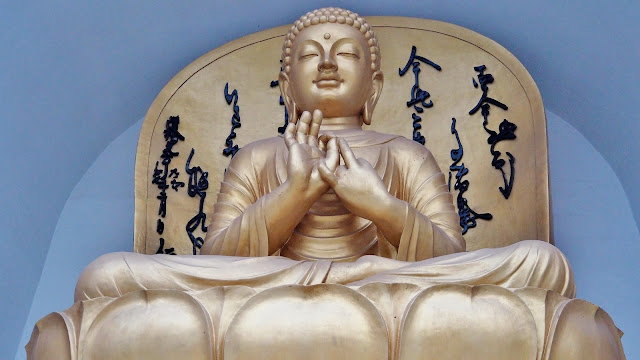
The top portion of Vaishali World Peace Pagoda houses Lord Buddha’s statues.

Vietnamese Buddhist Stupa - Vihara in Vaishali.
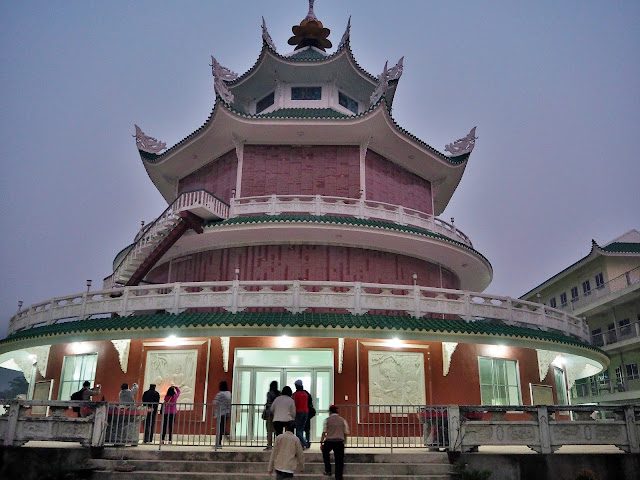
Vietnamese Buddhist Stupa - Vihara in Vaishali.

Vietnamese Buddhist Stupa - Vihara in Vaishali.

Vietnamese Buddhist Stupa - Vihara in Vaishali.

It was dinner time at Hotel Vaishali Residency and please eat all you can!

It was dinner time at Hotel Vaishali Residency and please eat all you can!

It was dinner time at Hotel Vaishali Residency and please eat all you can!

It was dinner time at Hotel Vaishali Residency and please eat all you can!

It was dinner time at Hotel Vaishali Residency and please eat all you can!

It was dinner time at Hotel Vaishali Residency and please eat all you can!

It was dinner time at Hotel Vaishali Residency and please eat all you can!

It was dinner time at Hotel Vaishali Residency and please eat all you can!

It was dinner time at Hotel Vaishali Residency and please eat all you can!

It was dinner time at Hotel Vaishali Residency and please eat all you can!

It was dinner time at Hotel Vaishali Residency and please eat all you can!
Vesali or Vaishali, capital of the Licchavis or Vajjis, was the headquarters of the powerful Vajjian confederacy of eight clans, of whom the Licchavis and Videhans were the most important. It was the first republic in the world modelled on the Aparihaniya Dhamma or the seven conditions leading to welfare, which the Buddha taught to the Vajjians when he was dwelling at the Saranda shrine in Vaishali. Thus united, they became so powerful that Ajatasattu of Magadha had to resort to treachery by sending the Brahmin Vassakara to sow discord among the Vajjian princes for three years in order to weaken them. By then, they were too disunited to defend their country and Ajatasattu conquered them.
The Buddha visited Vaishali several times, spending his 5th and 44th vassas there and many Licchavi nobles became his disciples. When Vaishali was plagued with famine, disease, and evil spirits, the Buddha was invited by the Licchavi nobles to help them alleviate the plagues. Buddha then preached the Ratana Sutta (Jewel Discourse) and instructed Ven. Ananda to go round the city walls reciting it as a Protection. Thereafter, the Buddha recited it for seven days and all the plagues then abated. But the event that elevated the status of Vaishali to an important pilgrimage site was the offering of a bowl of honey by a band of monkeys to the Blessed One, an incident mentioned among the Four Great Miracles in the Buddha’s life.
At Vaishali, the Buddha allowed women to be admitted to the Sangha after Ven. Ananda successfully pleaded to the Buddha for the ordination of Maha Pajapati Gotami and several Sakyan ladies. The Buddha then decreed the Eight Chief Rules, in addition to the Disciplinary Code observed by monks, which bhikkhunis or nuns “should revere, reverence, honour and respect for life and which should not be transgressed”. Thus the Bhikkhuni Sangha came to be established in Vaishali.
Once the Buddha was staying in a mango grove of Ambapali, the chief courtesan of Vaishali who invited him to a house dana, forestalling the Licchavi nobles who then offered her money in exchange for the invitation. But she politely declined their offer for she valued the dana more and after the meals, even donated her mango grove to the Buddha and Sangha. The Buddha spent the last vassa in Vesali where he relinquished the will to live at the Capala shrine. After the Mahaparinibbana, the Licchavis obtained a share of the Buddha’s relics from Kusinara and erected a grand stupa over the holy relics in Vaishali.
Vaishali is celebrated to possess the Buddha’s alms bowl, which he donated to them before his Parinibbana.
Pilgrimage Itinerary:
Day 01 (24.11.2014) Kuala Lumpur to Bangkok to Bodhgaya, India
Day 02 (25.11.2014) Bodhgaya to Dungeswari Cave - Sujata Stupa - Bodhgaya
Day 03 (26.11.2014) Bodhgaya to Rajgir by coach (80km, 3 hrs drive)
Day 04 (27.11.2014) Rajgir to Gijjhakuta Hill (Vulture Peak) - Nalanda - Rajgir
Day 05 (28.11.2014) Rajgir to Vaishali by coach (130km, 5 hrs drive)
Day 06 (29.11.2014) Vaishali to Kushinagar by coach (180km, 6hrs drive)
Day 07 (30.11.2014) Kushinagar to Lumbini by coach (160km, 7hrs drive)
Day 08 (01.12.2014) Lumbini in, Nepal
Day 09 (02.12.2014) Lumbini to Sravasti by coach (250Km, 8hrs drive)
Day 10 (03.12.2014) Sravasti to Varanasi by coach (270Km, 11 hrs. drive)
Day 11 (04.12.2014) Varanasi to Sarnath. Varanasi to Bangkok TG328 16:30hrs 21:15hrs
Day 12 (05.12.2014) Bangkok to Kuala Lumpur
///
Day 01 (24.11.2014) Kuala Lumpur to Bangkok to Bodhgaya, India
Day 02 (25.11.2014) Bodhgaya to Dungeswari Cave - Sujata Stupa - Bodhgaya
Day 03 (26.11.2014) Bodhgaya to Rajgir by coach (80km, 3 hrs drive)
Day 04 (27.11.2014) Rajgir to Gijjhakuta Hill (Vulture Peak) - Nalanda - Rajgir
Day 05 (28.11.2014) Rajgir to Vaishali by coach (130km, 5 hrs drive)
Day 06 (29.11.2014) Vaishali to Kushinagar by coach (180km, 6hrs drive)
Day 07 (30.11.2014) Kushinagar to Lumbini by coach (160km, 7hrs drive)
Day 08 (01.12.2014) Lumbini in, Nepal
Day 09 (02.12.2014) Lumbini to Sravasti by coach (250Km, 8hrs drive)
Day 10 (03.12.2014) Sravasti to Varanasi by coach (270Km, 11 hrs. drive)
Day 11 (04.12.2014) Varanasi to Sarnath. Varanasi to Bangkok TG328 16:30hrs 21:15hrs
Day 12 (05.12.2014) Bangkok to Kuala Lumpur
///


Thank you very much for this sharing Neng Bin. I would really love to accompany you on your beautifully inspiring explorations. We have never met but have Song Poh as a common friend. Take care... God bless. With best wishes and warmest rewards, Anthony Wong SN
ReplyDeleteBro. Ching, you're simply awesome. I can't thank you enough for your kind sharing on Buddhist Pilgrimage to India.
ReplyDeleteYou're simply a prolific writer and I enjoyed so much reading your travelogue which is so enlightening.
May you and your family be blessed abundantly with good health, wealth and happiness always.
I'm glad that a XuanZang 玄奘和尚memorial Hall has been erected in India as a Indo-Chinese undertaking to mark their historical connection. 法显和尚Faxian and 义净和尚Yijing were two other notable monks who made it to India in search of Buddhist principles and scriptures. I am very impressed with the blogger's 1st pic with a mirror image of a placid lake, with a small boat in it. There're glimpses of rural and rather pristine scene of typical Indian village life. NB's sister BG has a large pair of eyes-a good looking lady. The 6km road bridge is in dire need of maintanance and perhaps substantial repair. The hotel beds seemed clean and tidy, wow, that could be a luxury. The meals were understandably vegetarian I believe. NB Ching's pilgrimage group to India was a big group; I'm surprised at the size of it. Regards, Alan Kok
ReplyDelete